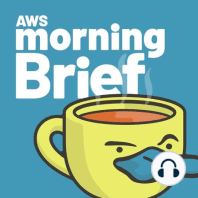1 min listen
Networking in the Cloud Fundamentals, Part 3
ratings:
Length:
16 minutes
Released:
Nov 14, 2019
Format:
Podcast episode
Description
About Corey QuinnOver the course of my career, I’ve worn many different hats in the tech world: systems administrator, systems engineer, director of technical operations, and director of DevOps, to name a few. Today, I’m a cloud economist at The Duckbill Group, the author of the weekly Last Week in AWS newsletter, and the host of two podcasts: Screaming in the Cloud and, you guessed it, AWS Morning Brief, which you’re about to listen to.TranscriptThis episode of Networking in the Cloud is sponsored by ThousandEyes. Their 2019 Cloud Performance Benchmark Report is now live as of yesterday. Find out which Clouds do what well, AWS, Azure, GCP, Alibaba, and IBM Cloud all have their networking capabilities raced against each other. Oracle was not invited, because we are talking about actual Cloud providers here, not law firms. Get your copy of the report today at Snark.Cloud/realclouds. That's Snark.Cloud/realclouds. That's completely free. Download it, let me know what you think. I'll be cribbing from that in future weeks. Now, for the third week of our AWS Morning Brief Screaming in the Network, or whatever we're calling it, mini-series on how computers talk to one another. Let's talk about the larger internet.Specifically, we begin with BGP, or Border Gateway Protocol. This matters, because it's how different networks talk to one another. If you have a whole bunch of different computer networks gathered into a super network, or internet as some people like to call it, how do those networks know where each one lives? Now, from a home user perspective, or even in some enterprises, that seems like sort of a silly question, because it is. You have a network that lives on your end of things. You plug a single cable in, and every other network lives through that cable. When you're talking about large disparate networks though, how do they find each other? More to the point, because of how the internet was built, it's designed so that any single failure of another network can now be routed around. There are multiple paths to get to different places. Some biased for cost, some biased for performance, some biased for consistency. And all of those decisions have to be made globally. BGP is the lingua franca of how those networks talk to one another. BGP is also a hot mess.It's the routing protocol that runs the internet, and it's comprised of different networks in this parlance, autonomous systems, or AS's, and it was originally designed for a time before jerks ruled the internet, and that's jerks in terms of people causing grief for others, as well as shady corporate interests that are publicly traded on NASDAQ. There's no authentication tied to BGP. Effectively, it is trusted to contain correct data. There is no real signing or authentication that someone who announces something through BGP is authorized to do it, and it's sort of amazing the whole thing works in the first place, but what happens is, is when a large network with other networks behind it winds up doing an announcement, it says, oh, I have routes to these following networks. And it passes them on to its peers. They in turn pass those announcements on, oh, behind me. Then this way two hops is this other series of networks, and so on and so forth.Now this can cause hilariously bad problems that occasionally make the front page of the newspaper when a bad announcement gets out. A few years ago there was an announcement from an ISP that said, oh, all of YouTube lives behind us. That announcement should never have gone out, and their upstream ISP should have quashed it, and they didn't. So suddenly a good swath of the internet was trying to reach YouTube through a relatively small link. As you can imagine, TCP terminated on the floor. Not every link can handle exabytes of traffic. Who knew? That gets us to another interesting point. How do these large networks communicate with each other? You have this idea of one network talks to another network. Does money change hands? Well
Released:
Nov 14, 2019
Format:
Podcast episode
Titles in the series (100)
Welcome to AWS Morning Brief: Welcome to AWS Morning Brief, the podcast that summarizes the news from the AWS ecosystem--and makes fun of it. by AWS Morning Brief
